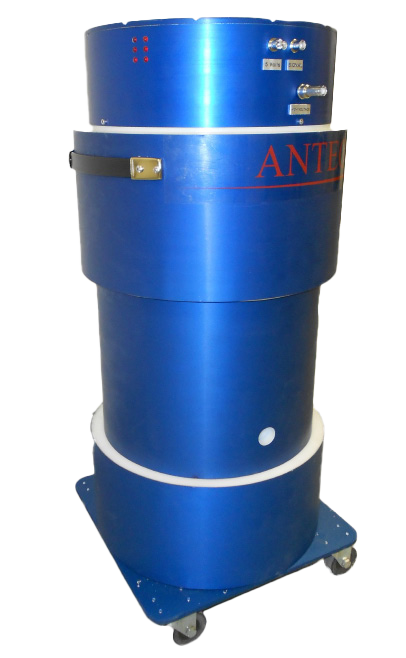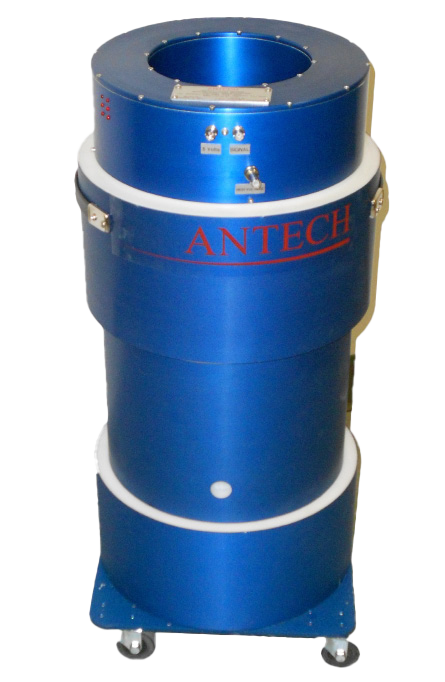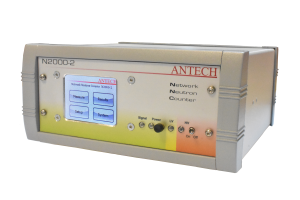The ANTECH Model N2018 High-Level Neutron Coincidence Counter is a medium efficiency passive neutron counter for measuring the spontaneous and induced fission from the even isotopes of plutonium bearing samples, including PuO2 mixed oxides, metal carbides, solution and scrap.
- High efficiency (18%) for the detection of ²⁴⁰Pu spontaneous fission neutrons
- Geometry designed to provide a flat radial and axial detection efficiency profile
- Designed for energy dependence of the detection efficiency as small as is reasonably practicable
- Can be used with most commercially available neutron coincidence and multiplicity counters for multiplicity distribution data collection
Benefits
- Detectors mounted in cylindrical HDPE moderator surrounding the sample well to optimise counting efficiency
- Annular ANTECH electrically screened Junction Box that ensures comprehensive electrical screening at the termination of the detector tubes
- Detectors grouped into 6 sets of three tubes, with each bank connected to one Amptek A111 amplifier/discriminator board
- Fast Amptek A111 based amplifier/discriminators reduce dead time effects for doubles and triples, especially at high count rates
- Different High Voltage, Signal and 5V connections to junction box to prevent incorrect connection
- Sample cavity lined with cadmium to prevent back scattering of thermalised neutrons
- Outer cadmium liner - clad with an aluminium cover - reduced neutron background
Features
-
Description
The Model N2018 is based on technology developed by the Los Alamos National Laboratory (LANL) for safeguards and inventory purposes. Conventional passive neutron coincidence counting of scrap and residues give rise to significant biases since the plutonium present is often in lumped form and mixed with significant quantities of low-z number impurities. The high α-ratio causes a general increase in the apparent correlated response through induced fission reactions that can lead to significant biases. In multiplicity counting, the number of signal multiplets (the signal frequency distribution) is measured in the neutron pulse train. From the moment of the neutron probability distribution it is possible to determine the number of neutron totals, the number of correlated neutron pairs and the number of correlated neutron triples. When one of the variables is known (or can be inferred), the data analysis employs a point source model to perform a four parameter analysis based frequency distribution to solve for the spontaneous fission rate, Fs (and hence the 240Pueffective mass), the detection probability (ε), the (α,n) source term (Sα) or the neutron multiplication, as appropriate.
The Model N2018 can be used with most commercially available neutron coincidence and multiplicity counters for multiplicity distribution data collection. It is particularly suitable for use with the ANTECH N2000 series of neutron counters.
The neutron detection system consists of 18 equi-spaced 3He tubes arranged in one ring. The unit is mounted on a robust base fitted with castors. One pair of castors can be locked for safety and stability.
-
Specifications
Measurement Chamber Dimensions410 mm H, 175 mm diameter 16.3" H, 6.9" diameterDetector18 x GE Model RS-P4-0820-103 tubes arranged in one ring.
Each detector 25.4 mm diameter, 50.8 mm active length, 4 atmospheres 1" diameter, 20" active lengthHV Bias Setting1680 VGate WidthTypically 64 μsDie Away Time50 μs with gate setting of 64 μs






